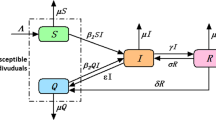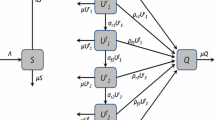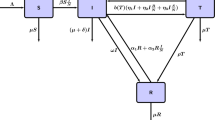Abstract
Substance abuse remains a global problem, with immense health and social consequences. Crystal meth, known as ‘tik’ in South Africa, is a growing problem, and its supply chains have equally grown due to increased numbers of ‘tik’ users, especially in the Western Cape province of South Africa. We consider a model for ‘tik’ use that tracks drug-supply chains, and accounts for rehabilitation and amelioration for the addicted. We analyse the model and show that it has a unique drug-free equilibrium. We prove that the drug-free equilibrium is globally stable when the reproduction number is less than one. We also consider both slow and fast dynamics, and show that there is a unique drug-persistent equilibrium when the reproduction number exceeds one. The model is fitted to data on ‘tik’ users in rehabilitation in the Western Cape province. A sensitivity analysis reveals that the parameters with the most control over the epidemic are the quitting rate of light-drug users and the person-to-person contact rate between susceptible individuals and ‘tik’ users. This suggests that programs aimed at light-drug users that encourage them to quit will be significantly more effective than targeting hard-drug users, either in quitting or in rehabilitation. Similarly, the person-to-person contact rate may be reduced by social programs that raise awareness of the dangers of ‘tik’ use and discourage light users from recruiting others.









Similar content being viewed by others
References
Blower, S. M., & Dowlatabadi, H. (1994). Sensitivity and uncertainty analysis of complex models of disease transmission: an HIV model, as an example. Int. Stat. Rev., 2, 229–243.
Burattini, M. N., Massad, E., & Coutinho, F. A. B. (1998). A mathematical model of the impact of crack-cocaine use on the prevalence of HIV/AIDS among drug users. Math. Comput. Model., 28, 21–29.
Diekmann, O., Heesterbeek, J. A. P., & Metz, J. A. J. (1990). On the definition and computation of the basic reproduction ratio R 0 in models of infectious diseases in heterogeneous populations. J. Math. Biol., 28, 503–522.
De Alarcon, R. (1969). The spread of a heroin abuse in a community. Bull. Narc., 21, 17–22.
Drug Library (1994). Substance use and transitions to abuse and addiction. Available from http://www.druglibrary.org/schaffer/library/studies/ota/ch5.htm.
Fenichel, N. (1979). Geometric singular perturbation theory for ordinary differential equations. Journal of Differential Equations, 31, 53–98.
Heffernan, J. M., Smith?, R. J., & Wahl, L. M. (2005). Perspectives on the basic reproductive ratio. J. R. Soc. Interface, 2, 281–293.
Hunt, L. G., & Chambers, C. D. (1976). The heroin epidemics. New York: Spectrum Publications 1976.
Kapp, C. (2008). Crystal meth boom adds to South Africa’s health challenges. Lancet, 371, 193–194.
LaSalle, J. P. (1976). CBMS-NSF regional conference series in applied mathematics: Vol. 25. The stability of dynamical systems. Philadelphia: SIAM.
Li, J., Blakeley, D., & Smith? R. J. (2011). The Failure of R 0. Comput. Math. Methods Med., 2011, 527610.
Lineberry, T. W., & Bostwick, J. M. (2006). Methamphetamine abuse: a perfect storm of complications. Mayo Clin. Proc., 81, 77–84.
Mackintosh, D. R., & Stewart, G. T. (1979). A mathematical model of a heroin epidemic: implications for control policies. J. Epidemiol. Community Health, 33, 299–304.
Magel, P. & Ruan, S. (Eds.) (2008). Structured population models in biology and epidemiology. Berlin: Springer.
Morojele, N. K., Parry, C. D. H., & Brook, J. S. (2009). Substance abuse and the young: taking action. MRC-South Africa research brief
Mulone, G., & Straughan, B. (2009). A note on heroin epidemics. Math. Biosci., 218, 138–141.
Nyabadza, F., & Hove-Musekwa, S. D. (2010). From heroin epidemics to methamphetamine epidemics: modelling substance abuse in a South African province. Math. Biosci., 225, 132–140.
Plüddemann, A., Dada, S., Parry, C., Bhana, A., Bachoo, S., Perreira, T., Nel, E., Mcweba, T., Gerber, W., & Freytag, K. (2010). Monitoring alcohol and drug abuse trends in South Africa (July 1996–June 2010). SACENDU research brief, 13(2).
Plüddemann, A., Parry, C., Flisher, A. J., & Jordaan, E. (2004). The nature and extent of heroin use in Cape Town: Part 2—a community survey. Available from http://www.mrc.ac.za.
Rossi, C. (2004). Operational models for the epidemics of problematic drug use: the mover-stayer approach to heterogeneity. Socio-Econ. Plan. Sci., 38, 73–90.
Sharomi, O., & Gumel, A. B. (2008). Curtailing smoking dynamics: a mathematical modelling approach. Appl. Math. Comput., 195, 475–499.
van den Driessche, P., & Watmough, J. (2002). Reproduction numbers and sub-threshold endemic equilibrium for compartmental models of disease transmission. Math. Biosci., 180, 29–48.
White, E., & Comiskey, C. (2007). Heroin epidemics, treatment and ODE modelling. Math. Biosci., 208, 312–324.
Acknowledgements
F. Nyabadza and J.B.H. Njagarah acknowledge, with thanks, the support of the University of Stellenbosch. J.B.H. Njagarah appreciates with gratitude the support from the African Institute for Mathematical Sciences (AIMS) South Africa. R.J. Smith? is supported by an NSERC Discovery Grant, an Early Researcher Award and funding from MITACS. For citation purposes, please note that the question mark in “Smith?” is part of his name.
Author information
Authors and Affiliations
Corresponding author
Rights and permissions
About this article
Cite this article
Nyabadza, F., Njagarah, J.B.H. & Smith, R.J. Modelling the Dynamics of Crystal Meth (‘Tik’) Abuse in the Presence of Drug-Supply Chains in South Africa. Bull Math Biol 75, 24–48 (2013). https://doi.org/10.1007/s11538-012-9790-5
Received:
Accepted:
Published:
Issue Date:
DOI: https://doi.org/10.1007/s11538-012-9790-5




